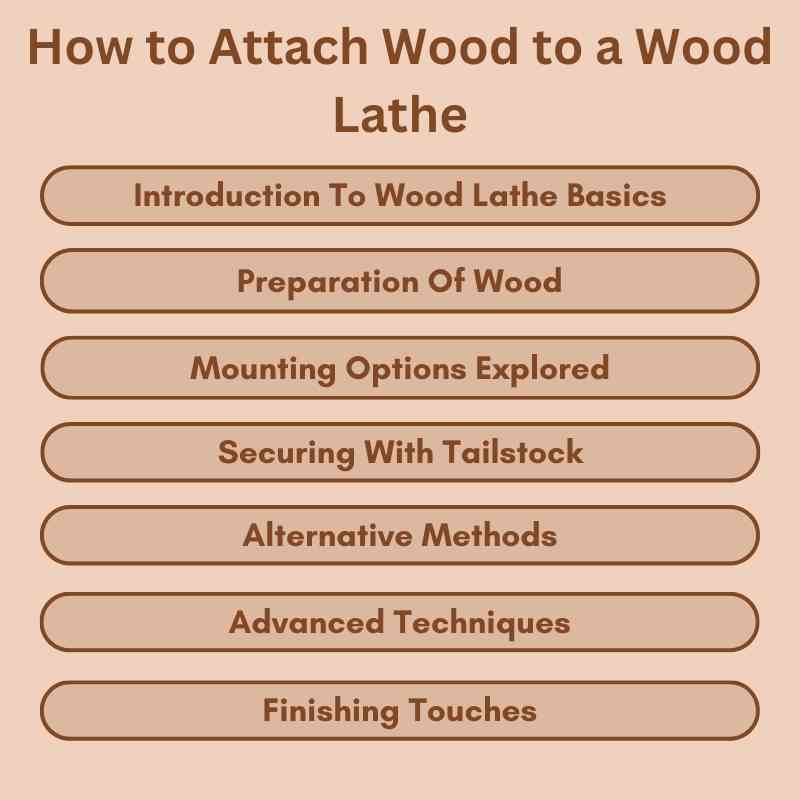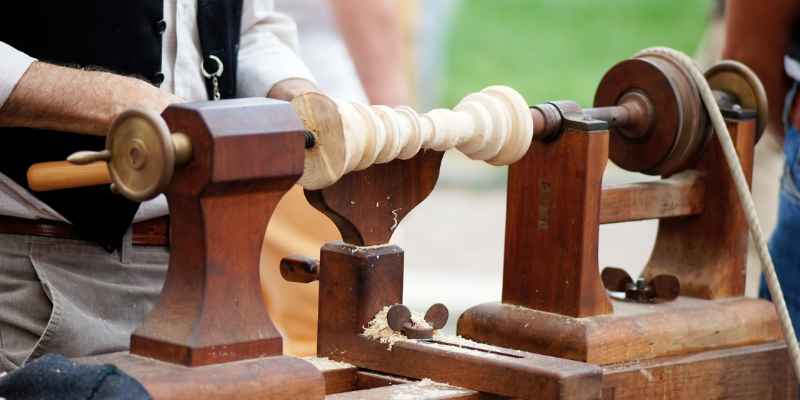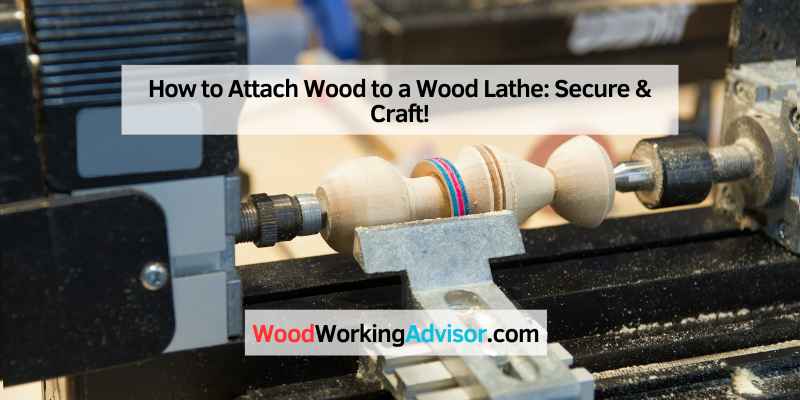To attach wood to a wood lathe, you can use a screw chuck for a secure and quick mounting option. The screw chuck involves using a screw to attach the wood at a single point on the lathe.
Additionally, faceplates with screw holes offer an affordable and secure way to attach wood to the lathe quickly and effectively. This method involves turning the face of the wood flat, drilling a hole for a tenon, and using the tailstock to support the work.
Overall, these methods provide efficient and reliable ways to attach wood to a wood lathe for turning and shaping.
Introduction To Wood Lathe Basics
When attaching wood to a lathe, safety measures are paramount. Prioritize selecting the right wood for your project. Use a screw chuck for quick and secure wood attachment, or opt for a faceplate for a tailstock-supported method. Ensure the wood is mounted securely to prevent accidents. Always use a four jaw chuck as an alternative for faceplate attachment, and consider collet chucks for versatility.
It’s essential to follow proper woodturning techniques to ensure a smooth and safe process. Utilize drive centers and DIY glue blocks for efficient wood attachment. Remember to use jam chucks for bowls and boxes, and explore vacuum chucks for varied projects. Understanding the different chucking methods is key to successfully attaching wood to a lathe.

Preparation Of Wood
When attaching wood to a wood lathe, one effective method is to use a screw chuck. This involves using a screw to securely attach the wood to the lathe at a single point. Another option is to use a faceplate, where the wood is mounted onto a flat surface using screws.
Both methods provide stability and allow for precise turning on the lathe.
Finding The CenterWhen attaching wood to a wood lathe, it is important to find the center of the wood for precise positioning. To do this, make a small indentation at the intersection of all the lines on the wood. Then, drive the spur center into the end grain of the wood. Insert the spur center into the lathe and mount the tailstock. Tighten down the tailstock to secure the piece of wood in place. Marking For PrecisionFor accurate turning, marking the depth on the wood is crucial. This can be done by using a depth gauge or marking the desired depth on the tool rest. Additionally, when using a faceplate, it is important to mark the center of the faceplate for proper alignment with the wood. This ensures that the wood is securely attached and properly balanced on the lathe. |
Mounting Options Explored
When attaching wood to a wood lathe, there are two main options to consider: using a screw chuck or a faceplate attachment. The screw chuck is an efficient option for mounting wood to the lathe and turning quickly and securely with a tailstock-free, exposed tenon work area.
It involves using a screw to attach the wood to the lathe at one solo point. On the other hand, the faceplate attachment method involves attaching scrap wood to the faceplate, turning the face of the wood flat, drilling a hole into the wood for a tenon, inserting the tenon on the turning blank, using the tailstock to support the work, and removing the tailstock to finish that part of the turning at the headstock end. Both methods offer effective ways to hold wood securely on the lathe, allowing for precise and controlled woodturning.
Securing With Tailstock
To attach wood to a wood lathe, you can secure it with the tailstock. This involves using the tailstock to support the workpiece, ensuring stability and safety during the turning process. By locking the tailstock, the wood is firmly held in place, allowing for precise and controlled shaping.
When it comes to securing wood to a wood lathe, the tailstock is a crucial component. Adjusting the tailstock is important to ensure stability while turning. The tailstock should be aligned with the headstock and the center of the wood piece. You can lock the tailstock in place by tightening the handle.
This will keep the wood piece from moving while you work. Additionally, using a faceplate or a screw chuck can also be effective methods for attaching wood to a lathe. The faceplate can be attached to the headstock and the wood can be screwed onto it. The screw chuck can be used to attach wood to the lathe at one solo point, providing a secure hold. By using these methods, you can safely and effectively attach wood to your wood lathe.
Alternative Methods
When it comes to attaching wood to a wood lathe, there are alternative methods you can use. One option is using a screw chuck, which allows for quick and secure mounting with a tailstock-free work area. Another method is using a faceplate, where you attach the wood to a flat surface and use a tenon for stability.
These methods ensure that your wood is securely attached for turning on the lathe.
| Alternative Methods: |
| Double Sided Tape Usage: |
| One alternative to attaching wood to a wood lathe is by using double sided tape. This method is best for smaller and lighter pieces of wood. Simply apply the tape to both the wood and the lathe and press them together. The tape will hold the wood securely while you turn it. |
| DIY Screw Chuck: |
| Another alternative is to use a DIY screw chuck. This involves drilling a hole in the center of the wood and screwing it onto the lathe using a wooden block and a screw. This method is efficient and allows for a tailstock-free, exposed tenon work area. |
Note: These alternative methods are useful when you don’t have a faceplate or when you’re working on smaller pieces of wood.
Advanced Techniques
When it comes to attaching wood to a wood lathe, one advanced technique is using a screw chuck. This efficient method allows for quick and secure turning, with a tailstock-free, exposed tenon work area. The screw chuck is a screw that attaches the wood to the lathe at a single point, providing stability during the turning process.
When it comes to advanced techniques in attaching wood to a wood lathe, vacuum chucking and reversing a bowl are two popular methods. Vacuum chucking involves using a vacuum to hold the wood in place while turning, allowing for more intricate designs and minimizing the need for tailstock support. Reversing a bowl involves removing the bowl from the lathe, flipping it over, and re-mounting it to finish the bottom side. Other methods include using a screw chuck or a faceplate to attach the wood to the lathe. It’s important to find a secure and efficient method that works for your project and skill level.
Finishing Touches
| Removing the Tailstock | Final Adjustments |
| When it comes to finishing touches while attaching wood to a wood lathe, it’s important to remove the tailstock if you are using a faceplate or a screw chuck. This will give you more room to work with and prevent any accidents. To remove the tailstock, simply loosen the locking mechanism and slide it off the bed of the lathe. | Before starting the turning process, make sure that the wood is securely attached to the lathe. Check for any wobbling or looseness. If everything looks good, start the lathe at a slow speed and gradually increase it. Always keep your hands away from the spinning wood and use a tool rest to support your tools. |
In order to attach wood to a wood lathe, there are several methods you can use such as a screw chuck, faceplate, or a tailstock. Each method has its own advantages and disadvantages, so it’s important to choose the right one for your project. A screw chuck is a quick and easy way to attach wood to a lathe, but it requires some skill to use properly. A faceplate is a good option if you need to turn the entire piece of wood, but it can be difficult to remove once you are finished. Finally, a tailstock can be used to support the other end of the wood, but it can also get in the way if you need more room to work with.
Safety And Maintenance
When attaching wood to a wood lathe, safety and maintenance are crucial. Dealing with stuck chucks requires careful handling to prevent accidents. Always ensure the lathe is properly maintained and free from defects. When using the lathe as a boring machine, prioritize safety to avoid injuries. Always follow safety guidelines and wear appropriate protective gear.

Frequently Asked Questions
How Is Wood Attached To A Lathe?
Attach wood to a lathe using a screw chuck or faceplate. Secure the wood by creating a tenon or using wood screws. Support the work with the tailstock, then remove it to finish turning. These methods provide a stable and efficient way to hold wood on the lathe.
How Do You Attach A Blank Wood To A Lathe?
To attach a blank wood to a lathe, use a faceplate or screw chuck for secure mounting. Drill a hole for the tenon, attach the wood, and use the tailstock for support. Finish by removing the tailstock and completing the turning at the headstock end.
What Holds The Wood On A Lathe?
The wood on a lathe is held using a faceplate or a screw chuck. The faceplate is a secure and affordable option that allows wood screws to firmly attach to a wood bowl blank. The screw chuck, on the other hand, uses a screw to attach the wood at a single point, providing a tailstock-free work area.
How To Secure A Piece In A Lathe?
To secure a piece in a lathe, you can use the tailstock or a faceplate. For the tailstock method, find the center of the wood and drive a spur center into the end grain. Insert the spur center into the tailstock and tighten it to secure the wood.
For the faceplate method, attach scrap wood to the faceplate, turn the face flat, drill a hole for a tenon, and insert the tenon on the turning blank. Use the tailstock for support and remove it when necessary.
Conclusion
To conclude, there are several effective methods for attaching wood to a wood lathe. One option is to use a screw chuck, which securely holds the wood in place with a single screw. Another method is to use a faceplate, which allows you to attach the wood using screws or other fasteners.
Additionally, collet chucks and four jaw chucks provide alternative options for mounting wood on the lathe. By understanding and utilizing these techniques, you can ensure a secure and efficient woodturning process. Happy woodworking!

